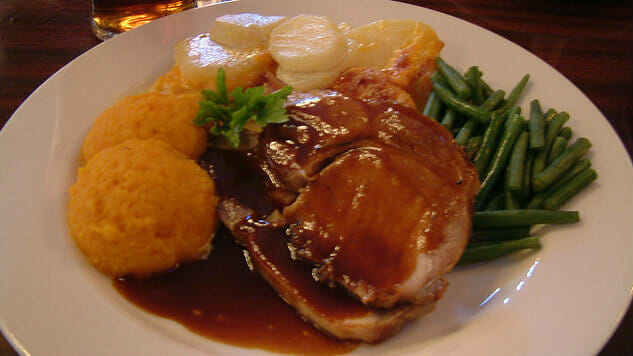Step Aside, Corned Beef: Pork is the Original St. Paddy’s Day Meal

They say everyone’s Irish on St. Patrick’s Day, but growing up in one of the oldest Irish settlements in the Midwest, everyone was Irish every day. We had the oldest continually-licensed tavern in the state — a pub that bears an Irish name to this day — and today’s holiday was celebrated with special gusto.
Every St. Paddy’s Day, come later afternoon or very early evening, my mom would usher us all downtown to that tavern for a bowl of beef stew before it began to fill up with locals and visitors. The entire pub would celebrate, packed to the gills with people until it was standing room only, everyone shoulder-to-shoulder until the wee hours of the morning, imbibing in a constant flow of green beer, straight from the tap.
It wasn’t until I was a teenager that I realized most Irish-Americans celebrate St. Paddy’s with a meal of corned beef rather than beef stew, and it wasn’t until I was an adult that I learned that Irishmen would just as soon have pork on their table as beef — for this holiday and every day, for that matter.
The pig is firmly ensconced in Irish culture. Ancient Irish folklore tells us that one night, Saint Martin bestowed the a piece of fat upon a girl at a farmhouse in the countryside. Wise, or perhaps kind and culinarily-inclined, Saint Martin saw that the farmer had a surplus of grain and chaff, and no animals to eat it. He told the girl to put the piece of fat under a tub overnight. In the morning when she looked inside, there was a magical gift only a saint could materialize — a sow and twelve pigs where the fat had been.
Beloved folkloric place aside, how did the pig become the Irish favorite? The thing is, throughout most of Ireland’s history cows were regarded highly for their milk, and considered too valuable to be used for meat. Royalty and the particularly wealthy could afford beef for special occasions, but not the commoner — especially in the days St. Martin would have been wandering around supposedly creating animals out of everyday objects. (He’s said to have thrown a mitten at a bunch of mice and rats to create the cat at the same farm. Given the era, it’s probably just a good thing he hadn’t done this in a more Protestant country where the girl would, no doubt, have been accused of witchcraft when she turned up with never-before-seen creatures, and burned at the stake.)
-

-

-

-

-

-

-

-

-

-

-

-

-

-

-

-

-

-

-

-

-

-

-

-

-

-

-

-

-

-

-

-

-

-

-

-

-

-

-

-








































